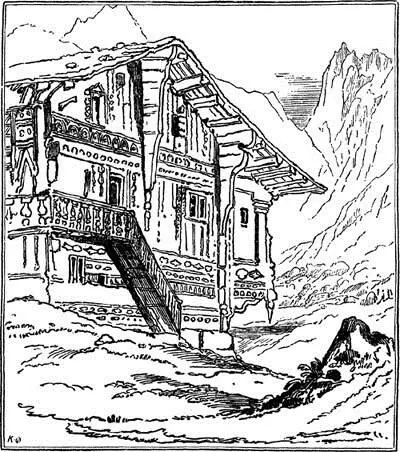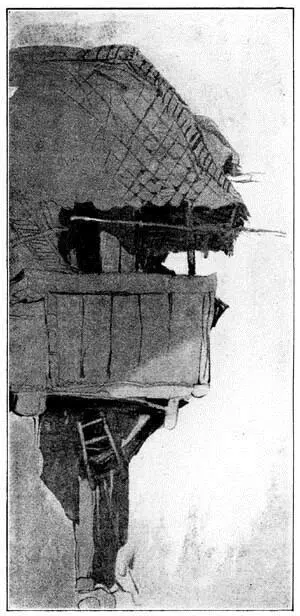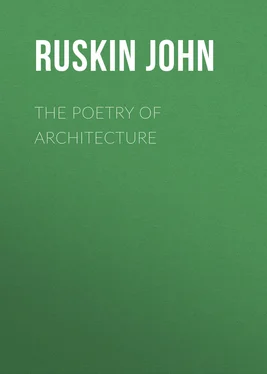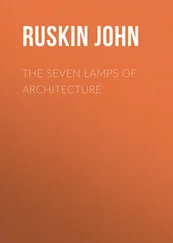John Ruskin - The Poetry of Architecture
Здесь есть возможность читать онлайн «John Ruskin - The Poetry of Architecture» — ознакомительный отрывок электронной книги совершенно бесплатно, а после прочтения отрывка купить полную версию. В некоторых случаях можно слушать аудио, скачать через торрент в формате fb2 и присутствует краткое содержание. Жанр: foreign_antique, foreign_home, literature_19, visual_arts, на английском языке. Описание произведения, (предисловие) а так же отзывы посетителей доступны на портале библиотеки ЛибКат.
- Название:The Poetry of Architecture
- Автор:
- Жанр:
- Год:неизвестен
- ISBN:нет данных
- Рейтинг книги:5 / 5. Голосов: 1
-
Избранное:Добавить в избранное
- Отзывы:
-
Ваша оценка:
- 100
- 1
- 2
- 3
- 4
- 5
The Poetry of Architecture: краткое содержание, описание и аннотация
Предлагаем к чтению аннотацию, описание, краткое содержание или предисловие (зависит от того, что написал сам автор книги «The Poetry of Architecture»). Если вы не нашли необходимую информацию о книге — напишите в комментариях, мы постараемся отыскать её.
The Poetry of Architecture — читать онлайн ознакомительный отрывок
Ниже представлен текст книги, разбитый по страницам. Система сохранения места последней прочитанной страницы, позволяет с удобством читать онлайн бесплатно книгу «The Poetry of Architecture», без необходимости каждый раз заново искать на чём Вы остановились. Поставьте закладку, и сможете в любой момент перейти на страницу, на которой закончили чтение.
Интервал:
Закладка:
41. But the winter residence, the Swiss cottage, properly so-called is a much more elaborate piece of workmanship. The principal requisite is, of course, strength: and this is always observable in the large size of the timbers, and the ingenious manner in which they are joined, so as to support and relieve each other, when any of them are severely tried. The roof is always very flat, generally meeting at an angle of 155°, and projecting from 5 ft. to 7 ft. over the cottage side, in order to prevent the windows from being thoroughly clogged up with snow. That this projection may not be crushed down by the enormous weight of snow which it must sometimes sustain, it is assisted by strong wooden supports (seen in Fig. 3), which sometimes extend half down the walls for the sake of strength, divide the side into regular compartments, and are rendered ornamental by grotesque carving. Every canton has its own window. That of Uri, with its diamond wood-work at the bottom, is, perhaps, one of the richest. (See Fig. 4.) The galleries are generally rendered ornamental by a great deal of labor bestowed upon their wood-work. This is best executed in the canton of Berne. The door is always six or seven feet from the ground, and occasionally much more, that it may be accessible in snow; and is reached by an oblique gallery, leading up to a horizontal one, as shown in Figs. 3 and 4. The base of the cottage is formed of stone, generally whitewashed. The chimneys must have a chapter to themselves; they are splendid examples of utility combined with ornament.

Fig. 3. Swiss Cottage. 1837.
Fig. 4. Cottage near Altorf. 1835.
Such are the chief characteristics of the Swiss cottage, separately considered. I must now take notice of its effect in scenery.
42. When one has been wandering for a whole morning through a valley of perfect silence, where everything around, which is motionless, is colossal, and everything which has motion, resistless; where the strength and the glory of nature are principally developed in the very forces which feed upon her majesty; and where, in the midst of mightiness which seems imperishable, all that is indeed eternal is the influence of desolation; one is apt to be surprised, and by no means agreeably, to find, crouched behind some projecting rock, a piece of architecture which is neat in the extreme, though in the midst of wildness, weak in the midst of strength, contemptible in the midst of immensity. There is something offensive in its neatness: for the wood is almost always perfectly clean, and looks as if it had just been cut; it is consequently raw in its color, and destitute of all variety of tone. This is especially disagreeable, when the eye has been previously accustomed to, and finds, everywhere around, the exquisite mingling of color, and confused, though perpetually graceful, forms, by which the details of mountain scenery are peculiarly distinguished. Every fragment of rock is finished in its effect, tinted with thousands of pale lichens and fresh mosses; every pine tree is warm with the life of various vegetation; every grassy bank glowing with mellowed color, and waving with delicate leafage. How, then, can the contrast be otherwise than painful, between this perfect loveliness, and the dead, raw, lifeless surface of the deal boards of the cottage. Its weakness is pitiable; for, though there is always evidence of considerable strength on close examination, there is no effect of strength: the real thickness of the logs is concealed by the cutting and carving of their exposed surfaces; and even what is seen is felt to be so utterly contemptible, when opposed to the destructive forces which are in operation around, that the feelings are irritated at the imagined audacity of the inanimate object, with the self-conceit of its impotence; and, finally, the eye is offended at its want of size. It does not, as might be at first supposed, enhance the sublimity of surrounding scenery by its littleness, for it provokes no comparison; and there must be proportion between objects, or they cannot be compared. If the Parthenon, or the Pyramid of Cheops, or St. Peter's, were placed in the same situation, the mind would first form a just estimate of the magnificence of the building, and then be trebly impressed with the size of the masses which overwhelmed it. The architecture would not lose, and the crags would gain, by the juxtaposition; but the cottage, which must be felt to be a thing which the weakest stream of the Alps could toss down before it like a foam-globe, is offensively contemptible: it is like a child's toy let fall accidentally on the hillside; it does not unite with the scene; it is not content to sink into a quiet corner, and personify humility and peace; but it draws attention upon itself by its pretension to decoration, while its decorations themselves cannot bear examination, because they are useless, unmeaning and incongruous.

Swiss Châlet Balcony, 1842.
43. So much for its faults; and I have had no mercy upon them, the rather, because I am always afraid of being biased in its favor by my excessive love for its sweet nationality. Now for its beauties. Wherever it is found, it always suggests ideas of a gentle, pure, and pastoral life. 6One feels that the peasants whose hands carved the planks so neatly, and adorned their cottage so industriously, and still preserve it so perfectly, and so neatly, can be no dull, drunken, lazy boors; one feels, also, that it requires both firm resolution, and determined industry, to maintain so successful a struggle against "the crush of thunder, and the warring winds." Sweet ideas float over the imagination of such passages of peasant life as the gentle Walton so loved; of the full milk-pail, and the mantling cream-bowl; of the evening dance and the matin song; of the herdsmen on the Alps, of the maidens by the fountain; of all that is peculiarly and indisputably Swiss. For the cottage is beautifully national; there is nothing to be found the least like it in any other country. The moment a glimpse is caught of its projecting galleries, one knows that it is the land of Tell and Winkelried; and the traveler feels, that, were he indeed Swiss-born and Alp-bred, a bit of that carved plank, meeting his eye in a foreign land, would be as effectual as a note of the Ranz des Vaches upon the ear.
44. Again, when a number of these cottages are grouped together, they break upon each other's formality, and form a mass of fantastic proportion, of carved window and overhanging roof, full of character and picturesque in the extreme. An excellent example of this is the Bernese village of Unterseen. Again, when the ornament is not very elaborate, yet enough to preserve the character, and the cottage is old, and not very well kept (suppose in a Catholic canton), and a little rotten, the effect is beautiful: the timber becomes weather-stained, and of a fine warm brown, harmonizing delightfully with the gray stones on the roof, and the dark green of surrounding pines. If it be fortunate enough to be situated in some quiet glen, out of sight of the gigantic features of the scene, and surrounded with cliffs to which it bears some proportion; and if it be partially concealed, not intruding on the eye, but well united with everything around, it becomes altogether perfect; humble, beautiful, and interesting. Perhaps no cottage can then be found to equal it; and none can be more finished in effect, graceful in detail, and characteristic as a whole.
45. The ornaments employed in the decoration of the Swiss cottage do not demand much attention; they are usually formed in a most simple manner, by thin laths, which are carved into any fanciful form, or in which rows of holes are cut, generally diamond shaped; and they are then nailed one above another to give the carving depth. Pinnacles are never raised on the roof, though carved spikes are occasionally suspended from it at the angles. No ornamental work is ever employed to disguise the beams of the projecting part of the roof, nor does any run along its edges. The galleries, in the canton of Uri, are occasionally supported on arched beams, as shown in Fig. 4, which have a very pleasing effect.
Читать дальшеИнтервал:
Закладка:
Похожие книги на «The Poetry of Architecture»
Представляем Вашему вниманию похожие книги на «The Poetry of Architecture» списком для выбора. Мы отобрали схожую по названию и смыслу литературу в надежде предоставить читателям больше вариантов отыскать новые, интересные, ещё непрочитанные произведения.
Обсуждение, отзывы о книге «The Poetry of Architecture» и просто собственные мнения читателей. Оставьте ваши комментарии, напишите, что Вы думаете о произведении, его смысле или главных героях. Укажите что конкретно понравилось, а что нет, и почему Вы так считаете.












